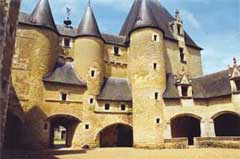Keep Castle
The early keep castle was of the keep-and-bailey plan, the plan which prevailed from the 10th to the 13th century. The motte and bailey type was only another version of the keep and bailey. In this type of castle the most important thing was the keep or donjon. Besides the donjon there was little else but a rampart and ditch. Until the middle of the 12th century, the donjon may be said to constitute in itself the whole castle.

Keep Castle: Arques Château in France
Nevertheless, it is highly probable that the baileys of castles were defended at first only with wooden ramparts on earthen banks, even when the donjon was of stone. The baileys of some of the most important castles in England had only these wooden and earthen defences, even as late as the 13th century, as proved from the Close Rolls. Colchester Castle had only a timber wall on the banks of its bailey as late as 1215, and in 1219 this palicium was blown down and an order issued for its reconstruction.
The stone keep castle arrangements were similar to the older, wooden ones. Provisions were stored in the basement, and the the guardhouse was usually on the first floor. The rooms of the lord and his lady were placed on the second floor. In case of a keep with three or four storeys, the best rooms were on the third floor. Generally, the keep had also an oratory, while the kitchen was in a separate building.
A variant of the keep and bailey type was the gatehouse keep. The most remarkable example of this kind in England is Exeter, which appears never to have had any keep but the primitive gatehouse built by Baldwin de Modes, the first builder of the castle. In Normandy, there are also examples of gatehouse keeps, among them Plessis-Grimoult, which has a fragment of a gatehouse tower, and also a mural tower on the line of the walls. The castle was ruined and abandoned in 1047. The gatehouse keep was an economical device for combining a citadel with the defence of the weakest part of the castle, which, according to the medieval architects, was the entrance.
The keep castle is well represented during the reign of Henry I, both in England and Normandy. According to Robert de Torigny, besides Rochester in England, the king built Arques, Gisors, Falaise, Domfront, and Evreux.
At Arques and Falaise the doorway is on the second floor, which is an innovation, in an attempt to solve the difficulty of defending the entrance. The first floor at Arques could only be entered by a trap from the second floor, while at Falaise there is a stone stair from one to the other. Rochester is entered from the first floor. The main floors in Henry I’s keep castles are always of wood. Henry I built at least one polygonal tower in Normandy, that of Gisors.
The keep castle masonry does not show notable advance in these examples. Falaise is built of small stones in herring-bone work, Domfront uses very small stones rudely coursed, Rochester is of Kentish mixed with flint rubble. Both Falaise and Domfront have plinths of superior masonry, but there is a possibility that these plinths are later additions.
Great changes took place towards the end of the 12th century, due to the improvement in siege engines. The trébuchet was one of the most important, being able to throw much heavier stones than the largest catapult, and was more accurate. These new engines were also useful for defence, and this affected the architecture of castles, because flat roofs covered with lead, on which machines could be placed, substituted the former sloping roofs.
The introduction of the crossbow gave to the keep castle a defensive arm of the greatest importance. To use the crossbow in the defence of the castle, the keep was featured with special loopholes for shooting, splayed downwards, so that it was possible to aim at the wall foot.
At the end of the 12th century, the greatest architectural change in the construction of the keep castle was the victory of the round keep over the square keep. Until then, the keep appears to have been mainly of the square form, with the polygonal one as a transitional form.
One of the most famous keeps is the White Tower of the Tower of London, constructed by William the Conqueror after the Conquest. The highest keep was the superb donjon at Coucy in Picardie, destroyed during the First World War. This leaves the donjon at Vincennes as the tallest keep in existence.
The age of the keep castle lasted until the 13th century, when the keep-less castle was introduced.

